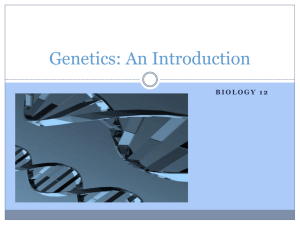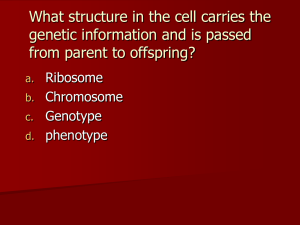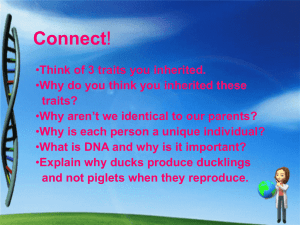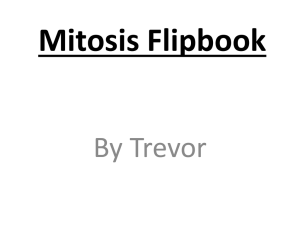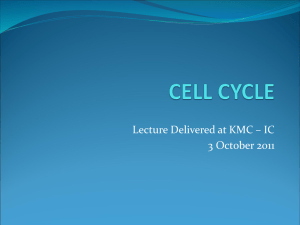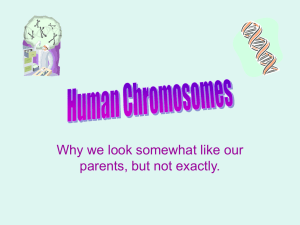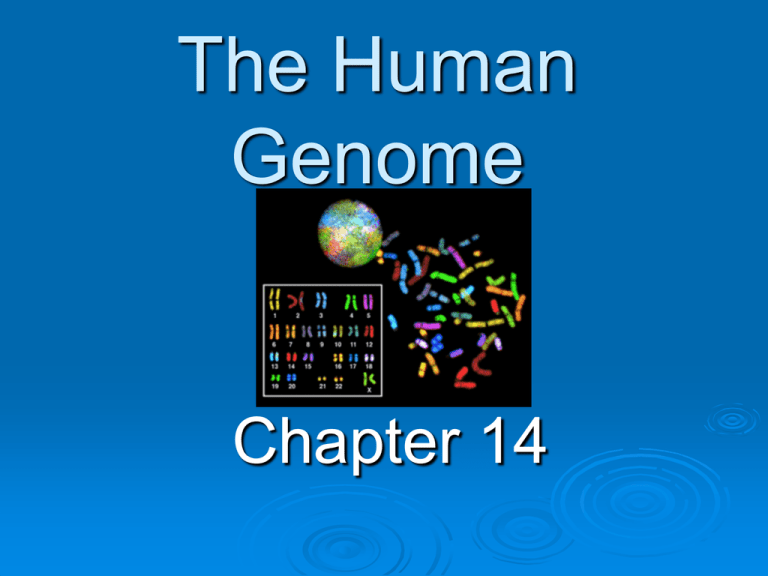
The Human
Genome
Chapter 14
Human Heredity
Human
chromosomes
Karyotype – a
picture of
chromosomes
arranged in pairs
Human Heredity
Human Heredity
Human body
• 46 chromosomes
Haploid sperm cell
with 23
chromosomes
Haploid egg cell with
23 chromosomes
They form a diploid
zygote or fertilized
egg cell with 46
chromosomes
Human Heredity
Sex chromosomes
• 2 of the 46
chromosomes
• Determine the sex
of that person
Females have X
and X or XX
chromosomes
Males have X and Y
or XY chromosomes
Human Heredity
Autosomes
(Autosomal
Chromosomes)
• The other 44
chromosomes found
in all body cells
• These are the
chromosomes
separate from the
sex cells
• Typically numbered
on a karyotype
Human Heredity
Human
traits
Pedigree chart
– Shows the
relationship
within a family
• Shows how traits
may be passed
through
generations
Human Heredity
Human
genes
Blood group genes
• Rh blood groups
Positive and
negative
Rh+ is dominant
• ABO blood groups
IA, I B, and i
IA and I B are
codominant
Human Heredity
Recessive alleles
• Genetic disorders
usually are not
discovered until seen
in the environment
Dominant alleles
• Anyone having
carrying an allele will
have the disorder
Codominant alleles
Human Heredity
From
gene to
molecule
Cystic fibrosis
• Common in people
from northern Europe
• Serious digestive and
breathing problems
• Caused by the
deletion of just one
amino acid
Human Heredity
Sickle cell disease
• Blood cells doughnut
or comma shaped
• Heterozygous
people don’t contract
malaria
• Humans with all
sickle celled blood
can die
• Why do so many
African Americans
have sickle celled
blood?
14-2 Human Chromosomes
Human
genes and
chromosomes
One cell has 6
billion base pairs or
A,C,T,& G
46 Chromosomes
are found in every
diploid human cell
14-2 Human Chromosomes
Only 2% of all DNA
is used for genes or
transcribed into
RNA
Average genes are
3,000 base pairs
Largest gene is 2
million base pairs
14-2 Human Chromosomes
Chromosomes 21
and 22 are the
smallest
• 22 has 545 genes (43
million base pairs)
• 21 has 225 genes (21
million base pairs)
Lou Gehrig’s Disease
or Amyotrophic
Lateral
Sclerosis(ALS)
14-2 Human Chromosomes
genes –
genes located on the
sex chromosomes
Sex-linked
Colorblindness
• Red-green
colorblindness
1 in 10 males
1 in 100 females
Why do more males
have colorblindness?
14-2 Human Chromosomes
Hemophilia
• Blood does not clot
properly
• Is determined by
two genes on the
X-chromosome
• 1 in 10,000 males
• Ryan White
14-2 Human Chromosomes
Duchenne
Muscular
Dystrophy
• Progressive
weakening and loss
of skeletal muscle
• 1 in 3,000 males
• Caused by a
defective gene that
codes for a protein in
muscles
14-2 Human Chromosomes
X-chromosome
inactivation
Barr body – dense
area in a nucleus
where the inactivated
X chromosome is
located
Each cell controls
which X
chromosome is
turned off
• Calico cat
14-2 Human Chromosomes
Chromosomal
Disorders
Nondisjunction –
error in which
homologous
chromosomes fail
to separate
14-2 Human Chromosomes
Down syndrome
• Caused by trisomy
or three copies of
chromosome
21(Trisomy 21)
• 1 in 800 babies
• This is a
nondisjunction
condition
14-2 Human Chromosomes
Sex
chromosome
disorders
Turner’s syndrome
• Females (45,X)
• Sterile
• No sex organs
Klinefelter’s
syndrome
• Males (47, XXY)
• Sterile
14-3 Human Molecular
Genetics
Human
DNA analysis
Search the human
genome using
sequences of DNA
bases
14-3 Human Molecular
Genetics
Testing for alleles
• Use labeled DNA
probes
• Search for changes in
restriction enzymes
• Test lengths of DNA
strands
14-3 Human Molecular
Genetics
DNA
fingerprinting
• No two
humans are
exactly alike
• Analyze and
compare low
function DNA
segments
14-3 Human Molecular
Genetics
The
Human
Genome Project
An ongoing effort
to analyze the
human sequence
Finished in 2000
14-3 Human Molecular
Genetics
Rapid
sequencing
• Identify separated
regions of DNA
• Use these areas
as markers
• Shotgun
sequencing
14-3 Human Molecular
Genetics
Searching for
genes
• Find DNA
sequences
known to be
promoters
This is the
start of a
gene
14-3 Human Molecular
Genetics
A breakthrough for
everyone
• Public access to
Human genome
project
14-3 Human Molecular
Genetics
Gene
therapy
Changing the
gene that causes
a genetic disorder
• Use viruses to
infect cells with
good gene
• 1999 - First
person cured of
genetic disorder
14-3 Human Molecular
Genetics
Ethical
issues
in human
genetics
Should we use
genetics to
make people
better?

